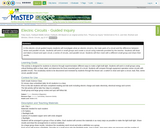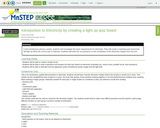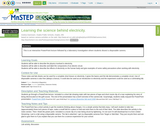
Students will use paper circuits to label various parts of the skeletal system.
- Subject:
- Biology
- Computer Science
- Engineering
- Healthful Living
- STEM
- Material Type:
- Activity/Lab
- Author:
- William Allred
- Carrie Robledo
- Date Added:
- 06/08/2021

Students will use paper circuits to label various parts of the skeletal system.

In this physics lab students will investigate whether Ohm's Law applies to common electric devices (incandescent light bulbs and LEDs). Students will design a controlled experiment, including a written procedure, and then conduct the experiment, collect and graph data. Students may submit their findings in a formal written report or through informal class discussion.

In this electric circuit guided inquiry students will investigate what an electric circuit is, the main parts of a circuit and the difference between series and parallel circuits. Students will work in small groups and create a circuit using materials provided by the teacher. Students will draw and label a closed and open circuit, a series of circuits, and parallel circuit. Students will then meet with a different small group and share their results.

This 1-2 hour activity was developed by Science Friday educator collaborative for middle school science. Students will "reverse-engineer a solar circuit to build a simple, inexpensive, and lightweight device that is powered by the sun’s light...in order to...integrate their circuit into a moveable origami structure so that the movement of the origami serves as the switch to the circuit."
Simple dollar store solar stake lights can be used for the disassembly which can be demonstrated by the teacher or completed in small groups. By reverse engineering the solar light, students explore the components and how they work together. The second activity has them sketching and explaining what they discovered.
Resources are included that explain solar cells and circuits more in depth (including a text webpage from American Chemical Society, a video from SciToons on YouTube, and an online circuit simulation from PhET, among other choices for your class' needs).
The student engineering "notebook" and rubric are downloadable in Powerpoint and Word form, not just pdf.

In this introductory physics activity, students will investigate the basic requirements for electricity. They will create a simple circuit for a quiz board that will light up when the correct matching pair is selected. Students will create six questions and answers for the quiz board, using electricity vocabulary terms.

In this advanced physics lesson, students will review electricity and circuitry concepts through a Power Point presentation and then dissect a disposable camera to investigate the internal circuit structure.

In this lab activity, students will design and build a complete circuit, record diagrams and notes in their journals, and use a compass to record the directionality of electricity in the circuit.